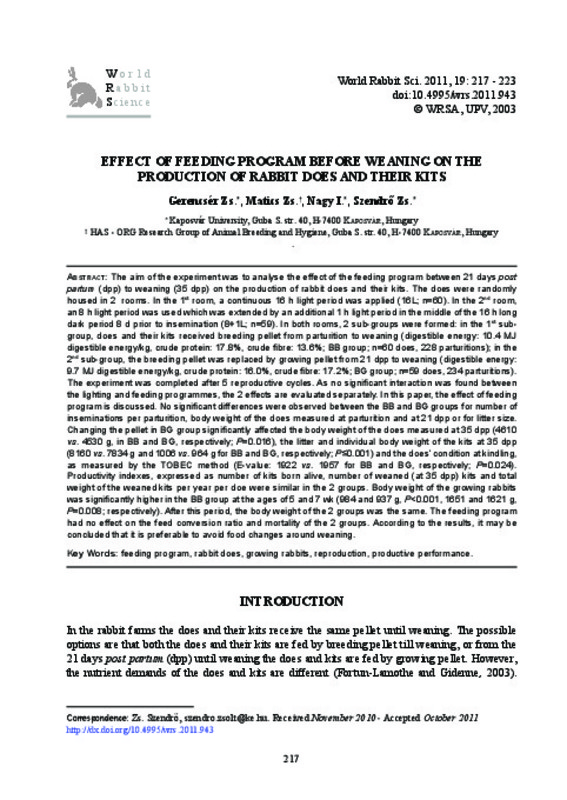JavaScript is disabled for your browser. Some features of this site may not work without it.
Buscar en RiuNet
Listar
Mi cuenta
Estadísticas
Ayuda RiuNet
Admin. UPV
Effect of lighting schedule on production of rabbit does
Mostrar el registro sencillo del ítem
Ficheros en el ítem
| dc.contributor.author | Gerencsér, Zsolt
|
es_ES |
| dc.contributor.author | Matics, Zsolt
|
es_ES |
| dc.contributor.author | Nagy, István
|
es_ES |
| dc.contributor.author | Szendro, Zsolt
|
es_ES |
| dc.date.accessioned | 2012-01-11T08:16:25Z | |
| dc.date.issued | 2011 | |
| dc.identifier.issn | 1257-5011 | |
| dc.identifier.uri | http://hdl.handle.net/10251/14327 | |
| dc.description.abstract | [EN] The aim of the experiment was to analyse the effects of the lighting schedule on the rabbit does' production. The does were randomly housed in two rooms at the age of 11 weeks. In the first room, a continuous 16-hour light period was applied (8:00-24:00) (16L:8D, control group; n=60 does, 239 parturitions). In the second room, an 8-hour light period was used (8:00-16:00) which was extended by an additional 1 hour light period in the middle of the 16-hour long dark period (23:00-24:00) 8 days prior to insemination (8L:7D:1L:8D, treated group; n=59 does, 223 parturitions). The experiment was finished after 5 reproductive cycles. Significant differences were obtained for body weight of the does (higher in treated group, P<0.05), litter size (control and treated groups: total born = 9.23 and 8.69, born alive = 8.83 and 8.24, at day 35 = 8.29 and 7.84, P=0.015, P=0.006, P <0.001, respectively), litter weight, individual weight of kits, suckling mortality and for feed consumption between days 21 and 35 of the lactation period. No significant differences were observed for number of inseminations per parturition, feed intake between days 0-21 of lactation, the does' condition at kindling measured by the TOBEC method and doe survival. The annual performance per doe was superior in the control group for number of kits born alive (65.0 and 58.8, P=0.036), number of weaned (at day 35) kits (58.9 and 53.8, P=0.046) and total weight of the weaned kits (58.2 and 52.7 kg, P=0.049) compared to the treated group. According to the results, the additional one hour lighting period (treated group) had no favourable effect on production compared to the continuous 16-hour light. | es_ES |
| dc.description.sponsorship | The financial help of TECH_08_A3/2-2008-0384 (OM-00198/2008) project is gratefully acknowledged. | |
| dc.language | Inglés | es_ES |
| dc.publisher | Editorial Universitat Politècnica de València | es_ES |
| dc.relation.ispartof | World Rabbit Science | |
| dc.rights | Reserva de todos los derechos | es_ES |
| dc.subject | Lighting schedule | es_ES |
| dc.subject | Reproductive performance | es_ES |
| dc.subject | Rabbit | es_ES |
| dc.title | Effect of lighting schedule on production of rabbit does | es_ES |
| dc.type | Artículo | es_ES |
| dc.date.updated | 2012-01-09T13:58:45Z | |
| dc.identifier.doi | 10.4995/wrs.2011.944 | |
| dc.rights.accessRights | Abierto | es_ES |
| dc.description.bibliographicCitation | Gerencsér, Z.; Matics, Z.; Nagy, I.; Szendro, Z. (2011). Effect of lighting schedule on production of rabbit does. World Rabbit Science. 19(4):217-223. https://doi.org/10.4995/wrs.2011.944 | es_ES |
| dc.description.accrualMethod | SWORD | es_ES |
| dc.relation.publisherversion | http://doi.org/10.4995/wrs.2011.943 | |
| dc.description.upvformatpinicio | 217 | |
| dc.description.upvformatpfin | 223 | |
| dc.description.volume | 19 | |
| dc.description.issue | 4 | |
| dc.identifier.eissn | 1989-8886 |








